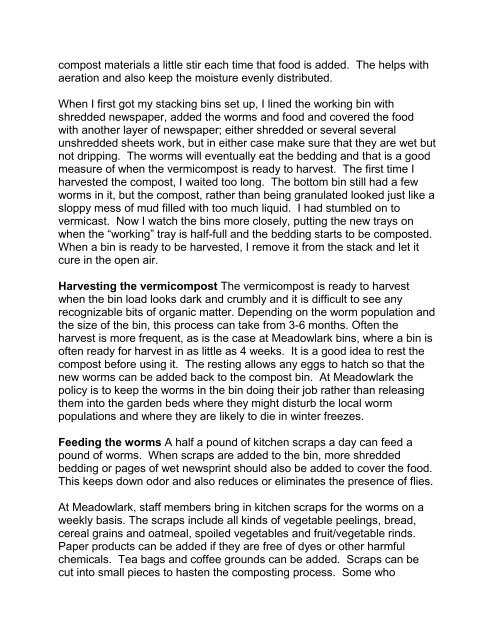VERMICOMPOST: WORMS DO IT - Fairfax County Master Gardeners
VERMICOMPOST: WORMS DO IT - Fairfax County Master Gardeners
VERMICOMPOST: WORMS DO IT - Fairfax County Master Gardeners
Create successful ePaper yourself
Turn your PDF publications into a flip-book with our unique Google optimized e-Paper software.
compost materials a little stir each time that food is added. The helps with<br />
aeration and also keep the moisture evenly distributed.<br />
When I first got my stacking bins set up, I lined the working bin with<br />
shredded newspaper, added the worms and food and covered the food<br />
with another layer of newspaper; either shredded or several several<br />
unshredded sheets work, but in either case make sure that they are wet but<br />
not dripping. The worms will eventually eat the bedding and that is a good<br />
measure of when the vermicompost is ready to harvest. The first time I<br />
harvested the compost, I waited too long. The bottom bin still had a few<br />
worms in it, but the compost, rather than being granulated looked just like a<br />
sloppy mess of mud filled with too much liquid. I had stumbled on to<br />
vermicast. Now I watch the bins more closely, putting the new trays on<br />
when the “working” tray is half-full and the bedding starts to be composted.<br />
When a bin is ready to be harvested, I remove it from the stack and let it<br />
cure in the open air.<br />
Harvesting the vermicompost The vermicompost is ready to harvest<br />
when the bin load looks dark and crumbly and it is difficult to see any<br />
recognizable bits of organic matter. Depending on the worm population and<br />
the size of the bin, this process can take from 3-6 months. Often the<br />
harvest is more frequent, as is the case at Meadowlark bins, where a bin is<br />
often ready for harvest in as little as 4 weeks. It is a good idea to rest the<br />
compost before using it. The resting allows any eggs to hatch so that the<br />
new worms can be added back to the compost bin. At Meadowlark the<br />
policy is to keep the worms in the bin doing their job rather than releasing<br />
them into the garden beds where they might disturb the local worm<br />
populations and where they are likely to die in winter freezes.<br />
Feeding the worms A half a pound of kitchen scraps a day can feed a<br />
pound of worms. When scraps are added to the bin, more shredded<br />
bedding or pages of wet newsprint should also be added to cover the food.<br />
This keeps down odor and also reduces or eliminates the presence of flies.<br />
At Meadowlark, staff members bring in kitchen scraps for the worms on a<br />
weekly basis. The scraps include all kinds of vegetable peelings, bread,<br />
cereal grains and oatmeal, spoiled vegetables and fruit/vegetable rinds.<br />
Paper products can be added if they are free of dyes or other harmful<br />
chemicals. Tea bags and coffee grounds can be added. Scraps can be<br />
cut into small pieces to hasten the composting process. Some who


